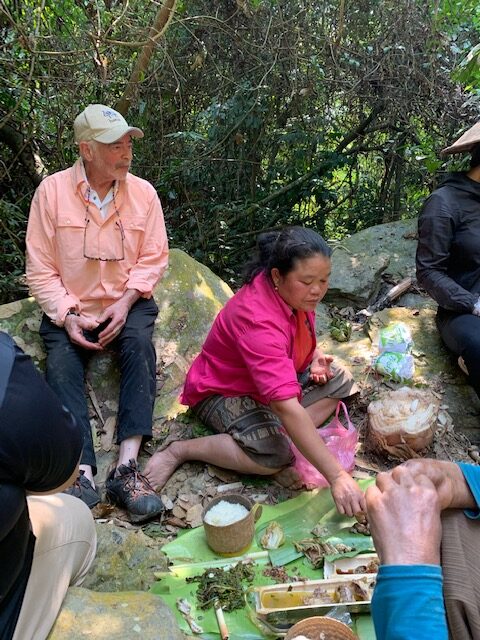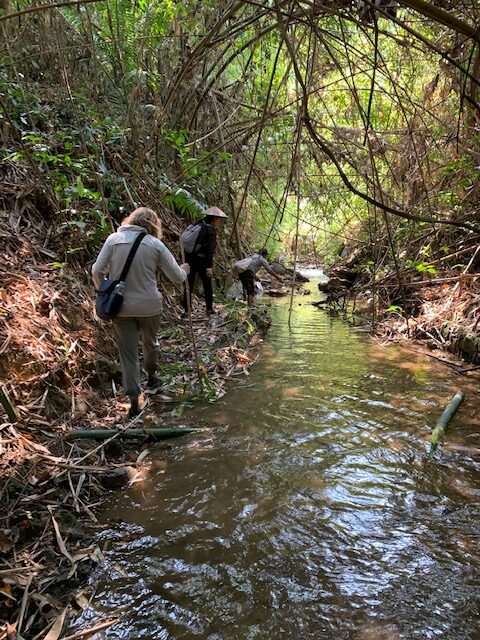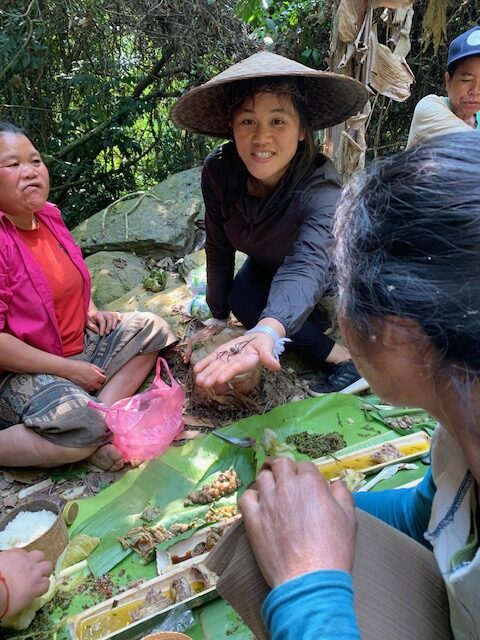Pangea’s First Visit to Green Community Volunteers, Laos
March 2023
By Paul Silver
Overview: On behalf of Pangea, I, accompanied by my intrepid spouse, Christina Marra, visited our new (and first) grantee in Laos, Green Community Volunteers (GCV) for three days. Founded in 2009, by an ethnic minority woman, GVC seeks to empower communities on environmental issues such as biodiversity preservation.

Site Visit: Two of the three co-directors of GCV, Dorn, who is GCV’s founder, and Linol, who is a volunteer lawyer, met us in Luang Prabang. From there we traveled by minivan approximately 3 hours north to the Ou River town of Nong Khiaw. We then traveled by boat approximately one hour further north on the Ou River to the town of Muang Ngoi, and checked into a comfortable guesthouse. The next morning, we traveled by boat to visit the village where GCV is conducting its “food forest” project (the Project Village).
The flow of the Ou River from its headwaters near the Chinese boarder south to where it joins the Mekong River near Luang Prabang is interrupted by a series of seven Chinese built and operated hydroelectric power dams, in effect converting the once free-flowing river into a series of slow-moving “reservoirs.” There is little storage capacity behind each of the dams. Consequently, to maintain electric power production, the operators of the dams manipulate the water flow causing frequent changes in the water depth and flow below the dams.
This has had a devastating impact on the lives of the people, mostly minority ethnic groups, who live along the river. Before the dams were built, the people who live along the river were dependent both for food and income on fish and shrimp from the river, harvesting a seaweed-like plant called “river weed” which they ate and also sold, and farming in riverside planting beds. Fish and shrimp stocks are now greatly diminished, riverweed is scarce and of poor quality, and the frequent changes in water level and flow precludes efficient farming on the banks of the river. Additionally, climate change has affected waterflow in the small stream tributaries of the Ou that run through the villages (too much water in the rainy season, flooding fields and paddies and washing out irrigation infrastructure; followed by drought in the hot season).

The residents of the Project Village are Khmu, one of the largest ethnic minority groups in Laos. They speak Khmu as their first language. Compared to the majority lowland Lao, the Khmu are poorer, mostly farmers, with limited access to educational and healthcare resources. As described in GCV’s grant application documents, the primary purpose of the “food forest” project is to empower villagers to improve their condition by providing information regarding modern agricultural practices related to food production, food production possibilities from forest areas (without deforestation), soil quality, use of organic fertilizers, and marketing of agricultural products.
It was difficult to determine the extent to which GCV has been successful in accomplishing these objectives. However, we were warmly welcomed to the village and accompanied on a walk through the village by a group of women including the spouse of the village headman, indicating that GCV’s activities were appreciated.

Now for the fun part: a hike to a waterfall. We were accompanied on this hike by 4 village women, including the headman’s spouse. The hike was challenging. Round trip, including a long lunch stop, it lasted about six hours and most of the time we walked in ankle to knee-deep water in the stream bed leading up to the waterfall, rather than on trails.
Along the way our enthusiastic guides demonstrated traditional “food-forest” foraging, including collecting snails from decaying bamboo canes, small crabs from under rocks, tiny fish, frogs, and a particular type of edible spider. Our guides also identified and harvested a number of different edible greens. At a relatively flat place below the falls, we had lunch. Big banana leaves were spread on the rocks for a tablecloth and our guides built a fire. Large diameter bamboo canes were cut in segments to use as cooking pots. The various lunch ingredients (mostly foraged, but some brought from the village), were cooked in the bamboo pots or grilled. Lunch included sticky rice and various mysterious looking condiments and concluded with local coffee (made by pouring water over grounds in a filter bag into bamboo segment cups) and homemade rice whiskey. By the end of lunch, we were all in a very good mood (although we did discover some leeches on our legs when we got back to the guest house).

The next day we returned to Luang Prabang the way we came, and our site visit ended.
